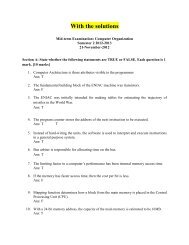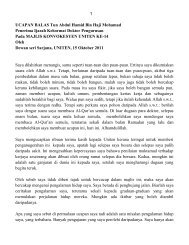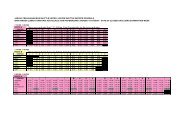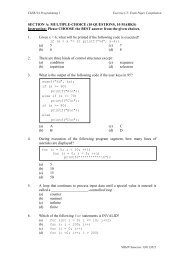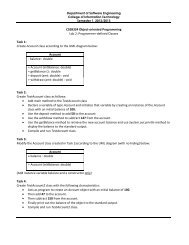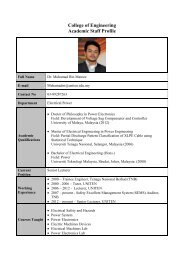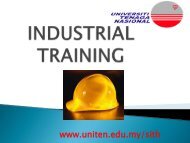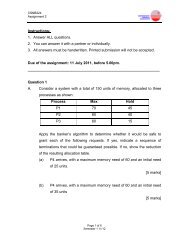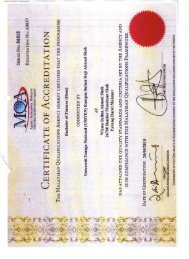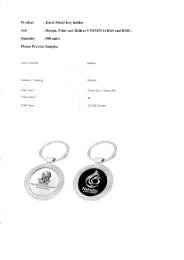07 External Memory - MetaLab
07 External Memory - MetaLab
07 External Memory - MetaLab
- No tags were found...
You also want an ePaper? Increase the reach of your titles
YUMPU automatically turns print PDFs into web optimized ePapers that Google loves.
William StallingsComputer Organizationand Architecture8 th EditionChapter 6<strong>External</strong> <strong>Memory</strong>[last updated March 2012]
Types of <strong>External</strong> <strong>Memory</strong>• Magnetic Disk• Optical• Magnetic Tape
Magnetic Disk• Disk – a circular platter constructed of nonmagneticmaterial called substrate• Disk is coated with a magnetizable material.• Substrate used to be aluminium• Now glass▫ Improved surface uniformity• Increases reliability▫ Reduction in surface defects• Reduced read/write errors▫ Better stiffness – to reduce disk dynamics▫ Greater ability to withstand shock and damage
Read and Write Mechanisms• Recording & retrieval via conductive coil called a head• May be single read/write head or separate ones• During read/write, head is stationary, platter rotates• Write▫ Current through coil produces magnetic field▫ Pulses sent to head▫ Magnetic pattern recorded on surface below• Read (traditional)▫ Magnetic field moving relative to coil produces current▫ Coil is the same for read and write• Read (contemporary)▫ Separate read head, close to write head▫ Partially shielded magneto resistive (MR) sensor▫▫Electrical resistance depends on direction of magnetic fieldHigh frequency operation• Higher storage density and speed
Inductive Write MR Read
Data Organization and Formatting• The head is a samall device capable of readingfrom or writing to a portion of the platterrotating beneath it.• Data are organize on the platter in a concentricset of rings called track.• Each track is the same width as the head.• Gaps- separate the adjacent tracks.• Data are transferred to and from the disk insectors.• Sectors can be fixed-length or variable length.
Disk Data Layout
Disk Velocity• Bit near centre of rotating disk passes fixed point slowerthan bit on outside of disk• Need mechanism so that the head can read all the bits atthe same rate.• How??▫ By increasing the spacing between bits of informationrecorded in segments of the disk.▫ The info can then be scanned at the same rate by rotatingthe disk at a fixed speed known as constant angular velocity(CAV).
Disk Layout Methods Diagram
Continue…• Fig. 6.3 (a) –CAV• The disk is divided into a number of pie-shapedsectors and into a series of concentric tracks.• Advantage of CAV:▫ The individual blocks of data can be directlyaddressed by tracks and sectors.• Disadvantage of CAV:▫ The amount of data that can be stored on the longouter tracks is the only same as what can be storedon the short inner tracks.
Multiple zone recording (MZR)• To increase density , a technique call MZR isintroduce.• In MZR, the surface is divided into a number ofconcentric zones• Within a zone, the number of bits per track isconstant• Zones farther from the center contain more bits(since more sectors) than zones closer to the center.• This allow greater storage capacity• However this require more complex circuitry
Physical characteristics• Head motion▫ Fixed head• One read write head per track• Heads mounted on fixed ridged arm▫ Movable head• One read write head per side• Mounted on a movable arm
Removable or Not• Removable disk▫ Can be removed from drive and replaced withanother disk▫ Provides unlimited storage capacity▫ Easy data transfer between systems• Nonremovable disk▫ Permanently mounted in the drive
Multiple Platter• One head per side• Heads are joined and aligned• Aligned tracks on each platter form cylinders• Data is striped by cylinder▫ reduces head movement▫ Increases speed (transfer rate)
Multiple Platters
Tracks and Cylinders
Classification of disk based on headmechanism• Tradiditonal R/W head has been positioned a fixeddistance above the platter-allowing an air gap.• Second is a head mechanism that actually comes intophysical contact with the medium during R/Woperation- used in floppy disk.• Floppy Disk▫ 8”, 5.25”, 3.5”▫ Small capacity• Up to 1.44Mbyte (2.88M never popular)▫ Slow▫ Universal▫ Cheap▫ Obsolete?
Continue..• The third one is the aerodynamic gap- winchester• The head must generate or sense an electromagneticfield of sufficient magnitude to write/read properly.• Winchester heads are used in sealed drive – free ofcontamination – able to reduce the risk of error• They are designed to operate closer to the disk’ssurface than conventional rigid disk heads allowinggreater data density.• The head is an aerodynamic foil that rests lightly onthe platter’s surface when the disk is motionless.
Disk performance parameters• The actual details of disk I/O operation dependon computer system, the OS and the nature ofthe I/O channel and disk controller hardware.• Fig. 6.7 – show general timing of disk I/Otransfer.
Timing of Disk I/O Transfer•Seek time- Moving head to correct track•(Rotational) latency/delay-Waiting for data to rotate underhead•Access time = Seek + Latency•Transfer rate-the time required for the transfer data
Optical Storage CD-ROM• Originally for audio• 650Mbytes giving over 70 minutes audio• The disk is formed from a resin such as polycarbonate.• Record data digitally (music/computer data)• Data recorded as a series of microscopic pits on thesurface of the polycarbonate.• How?▫ By using high-intensity laser to create a master disk▫ The master is used to make a die to stamp out copies ontopolycarbonate▫ The pitted surface is then coated with a highly reflectivesurface such as aluminium or gold▫ This shiny surface is protected against dust and scratchesby suing a top coat of clear acrylic▫ Finally a label can be silkscreened onto the acrylic
Continue..• Information is retrieve from a CD/CD-ROM by a low-powered laser housed in anoptical-disk player or drive unit• The laser shines through the clear polycarbonate while a motor spins the disk past it• The intensity of the reflected light of the laser changes as it encounters a pit• The areas between pits is called lands• A land is smooth surface which reflects back at higher intensity• The change between pits and lands is detected by a photosensor and converted into adigital signal.• The sensor tests the surface at regular intervals.• The beginning or end of a pit represents a 1, when no change in elevation occurbetween intervals, a 0 is recorded.
Continue..• Data on CD/CD-Rom is organized in a singlespiral track in a sequence of blocks• Sectors near the outside of the disk are the samelength as those near the inside.• Hence info is packed evenly across the disk insegments of the same size and these are scannedat the same rate by rotating the disk as a variablespeed.• The pits are then read by the laser as a constantlinear velocity (CLV).
Continue..• CD-ROM appropriate for large amount of data• It is removable• Disadvantages:▫ Read only-cannot be updated▫ The access time is longer compared to magneticdisk drive
Other Optical Storage• CD-Recordable (CD-R)▫ Write once read only memory (WORM)▫ Compatible with CD-ROM drives• CD-RW▫ Erasable▫ Getting cheaper▫ Mostly CD-ROM drive compatible▫ Can be rewritten and can used as secondarystorage similar to magnetic disk
DVD - what’s in a name?• Digital Video Disk▫ Used to indicate a player for movies• Only plays video disks• Digital Versatile Disk▫ Used to indicate a computer drive• Will read computer disks and play video disks
DVD - technology• Multi-layer• Very high capacity (4.7G per layer)• Full length movie on single disk▫ Using MPEG compression
High Definition Optical Disks• Designed for high definition videos• Much higher capacity than DVD▫ Shorter wavelength laser• Blue-violet range▫ Smaller pits• HD-DVD▫ 15GB single side single layer• Blue-ray▫ Data layer closer to laser• Tighter focus, less distortion, smaller pits▫ 25GB on single layer▫ Available read only (BD-ROM), Recordable once (BR-R) and re-recordable (BR-RE)
Magnetic Tape• Tape system use the same reading/writingtechnique as disk system.• Made from polyester tape coated withmagnetizable material.• Serial access• Slow• Very cheap• Backup and archive
Continue..• Data on the tape are structured as a number ofparallel tracks running lengthwise• Older version use parallel recording▫ Have 9 tracks▫ Store one byte at a time with additional parity bit▫ Later system have 18 or 36 tracks• Modern version use serial recording▫ Data are laid out as a sequence of bits along each tracksimilar to magnetic disks▫ Data read and write in contiguous blocks calledphysical records on a tape.▫ Typical recording technique used in serial tapes isreferred as serpentine recording.



